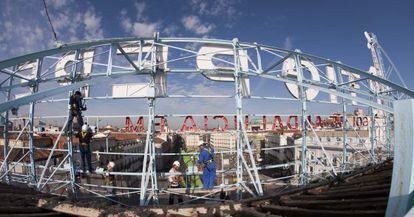Apple takes bite out of Sol as landmark Tío Pepe sign set to disappear forever
Iconic sherry ad will no longer be rebuilt on top of central Madrid building


It survived the Civil War, the complete makeover of Puerta del Sol in the 1980s, and even a city ordinance that wiped out hundreds of neon signs under Mayor Alberto Ruiz-Gallardón. The Tío Pepe billboard, depicting a giant bottle of sherry wine dressed in a red bullfighter’s jacket and a wide-brimmed hat, had sat atop Puerta del Sol number 1 for no fewer than 76 years.
The heavy structure was taken down last year to preserve it during restoration work inside the building. The former Hotel Paris had been sitting empty for five years, and its increasingly abandoned look had become a sore spot in the heart of the capital. Everyone expected Tío Pepe to be back by year’s end, but it was not to be. Now, it looks like it may never be back at all.
“The owners are not interested in putting the sign up again,” confirmed a spokeswoman for González Byass, the winery from Jerez that made the billboard in 1936 to celebrate its 100th anniversary. Late June marks the end of the lease between the winemaker and the current building owners (the Mexican family Díaz Estrada.) González Byass is negotiating with them to get the popular advertisement back in its place once the restoration work is over. “Our goal is to return it to the same spot,” insists the spokeswoman. But the owners appear to have made up their mind.
Was this decision conditioned by the fact that the next tenant of the building will be Apple? Nobody at the winery knows, and Apple neither confirms nor denies it, nor will it make any comment on the issue. As a matter of fact, they won’t even confirm that the next Apple Store to open in Madrid will be located in Puerta del Sol at all, despite the fact that the city-approved plan for the building lists the developer’s name as Apple Retail Store.
The next tenant of the building will be Apple, which refuses to comment on its plans
A change to city planning legislation allowed for one of the oldest luxury hotels in town to be turned over to office space and commercial establishments. “This initial permission makes it possible to restore a property that is very representative of 19th-century Madrid architecture, and which has a special meaning for Madrileños, who have always called it Tío Pepe after the advertisement that’s been crowning it for decades,” said a municipal press statement.
The people at González Byass say they have not given up yet, but admit they’ve been looking at alternative sites within Puerta del Sol. Meanwhile, the 25m-by-10m sign has just spent its first entire year locked up inside a warehouse in Alcalá de Henares.
A representative for the company that bought the hotel — originally built in 1893 and classified as a Level 1 protection site — told EL PAÍS last December that work was still at the structural consolidation stage.
Meanwhile, the Tío Pepe sign itself was scheduled for a complete facelift at a cost of between 150,000 and 200,000 euros, but that project has not gotten underway yet. González Byass is still waiting for a specific completion date on the building. What the billboard needs is to get its dents ironed out, and its letters and bottle figure sandpapered and repainted. Not much more can be done since the ad design is protected, noted the company spokeswoman last December.
A sign of the times
- In 1936, the Tío Pepe sign went up to celebrate the 100th anniversary of the Jerez winery González Byass. It is one of the oldest elements from the Puerta del Sol, even older than the Kilómetro Cero ground mark (1950), the bear and strawberry tree statue (1967) and the statue of King Carlos III on horseback (1994).
- Not even the Civil War bombings of 1936-1939 managed to eliminate the sign, which survived intact. In the mid-1980s it also remained untouched by the restoration of the square under Mayor Enrique Tierno Galván.
- In 2009 it was nearly axed by a city ordinance on street advertisement that prohibited excessive light emissions. But Tío Pepe survived that, too. On April 18, 2011 the sign was taken to a warehouse in Alcalá de Henares, some 30 kilometers from Puerta del Sol. It took eight workers three days to take it down.
Yet the billboard itself enjoys no protection whatsoever on Madrid’s list of landmarks. The city came out in its defense in 2009, when Gallardón’s personal crusade against light pollution almost did away with it. Against all odds, Tío Pepe remained where it was. It and three other historical ads were pardoned, including the Schweppes sign in Callao. It was as though Madrid had recognized the symbolic and sentimental value of its neon heritage. Of the city’s 1,503 street ads, 431 were removed in February 2010 for failing to meet ordinance standards.
But city officials are quick to note that this decision did not grant Tío Pepe special legal status. That is why there is little they can do to stop its disappearance. “It is a private contract between two parties,” said a municipal spokeswoman, who nevertheless admitted she would like to see the sign back, either on the same building or elsewhere in Puerta del Sol. “It’s part of the landscape.”










































